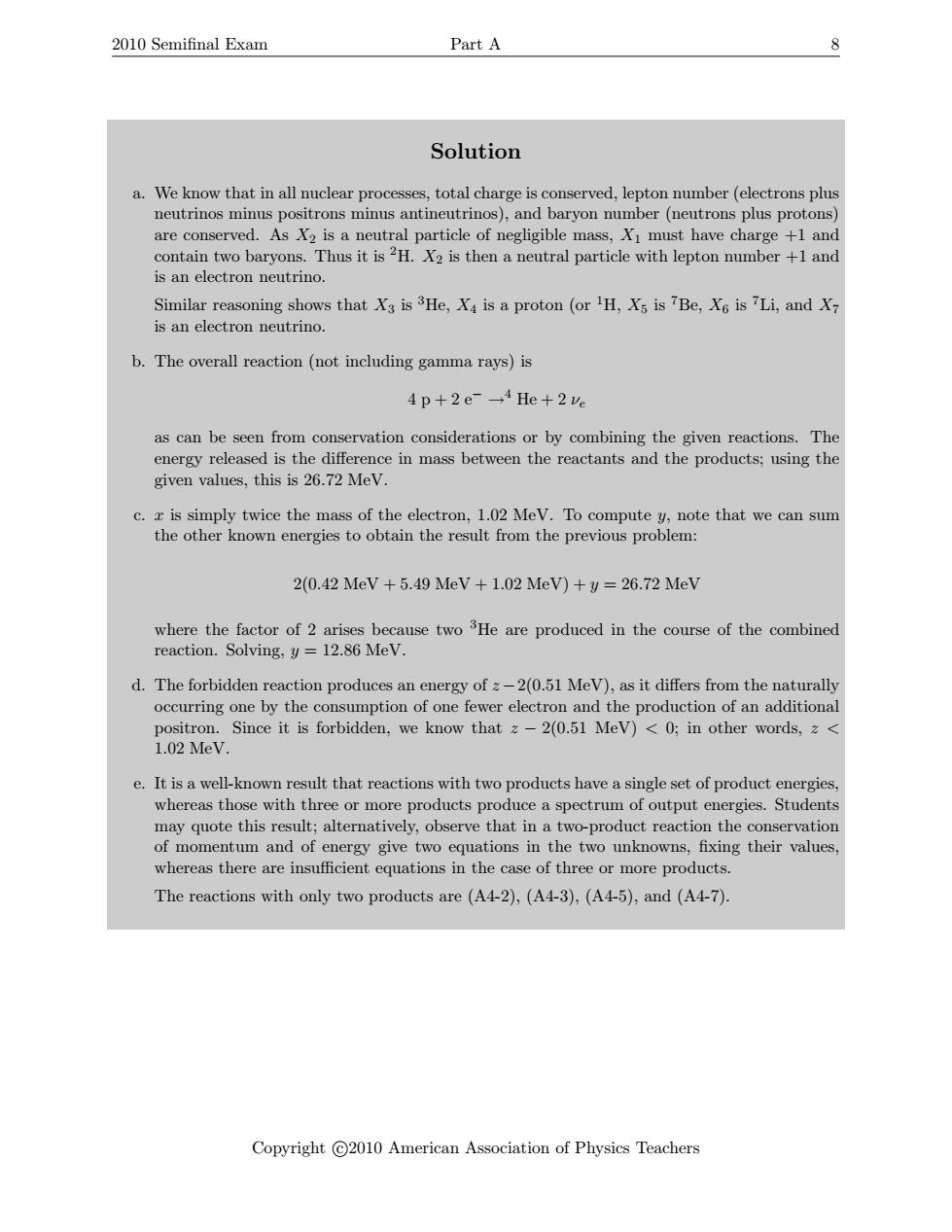正在加载图片...

2010 Semifinal Exam Part A 8 Solution a.We know that in all nuclear processes,total charge is conserved,lepton number(electrons plus neutrinos minus positrons minus antineutrinos),and baryon number(neutrons plus protons) are conserved.As X2 is a neutral particle of negligible mass,XI must have charge +1 and contain two baryons.Thus it is2H.X2 is then a neutral particle with lepton number +1 and is an electron neutrino. Similar reasoning shows that X3 is 3He,X4 is a proton (or H,X5 is 7Be,X6 is 7Li,and X7 is an electron neutrino. b.The overall reaction (not including gamma rays)is 4p+2e-4 He+2ve as can be seen from conservation considerations or by combining the given reactions.The energy released is the difference in mass between the reactants and the products;using the given values,this is 26.72 MeV. c.x is simply twice the mass of the electron,1.02 MeV.To compute y,note that we can sum the other known energies to obtain the result from the previous problem: 2(0.42MeV+5.49MeV+1.02MeV)+y=26.72MeV where the factor of 2 arises because two 3He are produced in the course of the combined reaction.Solving,y=12.86 MeV. d.The forbidden reaction produces an energy of z-2(0.51 MeV),as it differs from the naturally occurring one by the consumption of one fewer electron and the production of an additional positron.Since it is forbidden,we know that z-2(0.51 MeV)<0;in other words,z< 1.02MeV. e.It is a well-known result that reactions with two products have a single set of product energies, whereas those with three or more products produce a spectrum of output energies.Students may quote this result;alternatively,observe that in a two-product reaction the conservation of momentum and of energy give two equations in the two unknowns,fixing their values, whereas there are insufficient equations in the case of three or more products. The reactions with only two products are (A4-2),(A4-3),(A4-5),and(A4-7). Copyright C2010 American Association of Physics Teachers2010 Semifinal Exam Part A 8 Solution a. We know that in all nuclear processes, total charge is conserved, lepton number (electrons plus neutrinos minus positrons minus antineutrinos), and baryon number (neutrons plus protons) are conserved. As X2 is a neutral particle of negligible mass, X1 must have charge +1 and contain two baryons. Thus it is 2H. X2 is then a neutral particle with lepton number +1 and is an electron neutrino. Similar reasoning shows that X3 is 3He, X4 is a proton (or 1H, X5 is 7Be, X6 is 7Li, and X7 is an electron neutrino. b. The overall reaction (not including gamma rays) is 4 p + 2 e− →4 He + 2 νe as can be seen from conservation considerations or by combining the given reactions. The energy released is the difference in mass between the reactants and the products; using the given values, this is 26.72 MeV. c. x is simply twice the mass of the electron, 1.02 MeV. To compute y, note that we can sum the other known energies to obtain the result from the previous problem: 2(0.42 MeV + 5.49 MeV + 1.02 MeV) + y = 26.72 MeV where the factor of 2 arises because two 3He are produced in the course of the combined reaction. Solving, y = 12.86 MeV. d. The forbidden reaction produces an energy of z−2(0.51 MeV), as it differs from the naturally occurring one by the consumption of one fewer electron and the production of an additional positron. Since it is forbidden, we know that z − 2(0.51 MeV) < 0; in other words, z < 1.02 MeV. e. It is a well-known result that reactions with two products have a single set of product energies, whereas those with three or more products produce a spectrum of output energies. Students may quote this result; alternatively, observe that in a two-product reaction the conservation of momentum and of energy give two equations in the two unknowns, fixing their values, whereas there are insufficient equations in the case of three or more products. The reactions with only two products are (A4-2), (A4-3), (A4-5), and (A4-7). Copyright c 2010 American Association of Physics Teachers